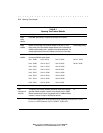
. . . . . . . . . . . . . . . . . . . . . . . . . . . . . .
&
'SQTEU7;7;7;(YEP7TIIH7[MXGL9WIV+YMHI
;VMXIV
*VER7TVEKIRW
4VSNIGX
7TERRMRK8VII'SRGITXW
'SQQIRXW
*MPI2EQI
CFHSG
0EWX7EZIH3R
%1
%TTIRHM\&
7TERRMRK8VII'SRGITXW
+IRIVEP
The IEEE 802.1D Spanning Tree Protocol resolves the problems of physical
loops in a network by establishing one primary path between any two switches
in a network. Any duplicate paths are barred from use and become standby or
blocked paths until the original path fails, at which point they can be brought
into service.
7TERRMRK8VII*IEXYVIW
The switch meets the requirements of the Spanning Tree Protocol (STP) by
performing the following functions:
■
Creates a single spanning tree from any arrangement of switching or
bridging elements.
238)
8LIXIVQlW[MXGLzMWYWIHEWERIUYMZEPIRXXSlFVMHKIzMR
XLMWHSGYQIRX
■
Compensates automatically for the failure, removal, or addition of any
device in an active data path.
■
Achieves port changes in short time intervals, which establishes a stable
active topology quickly with a minimum of network disturbance.
■
Uses a minimum amount of communications bandwidth to accomplish
the operation of the Spanning Tree Protocol.
■
Reconfigures the active topology in a manner that is transparent to
stations transmitting and receiving data packets.
■
Manages the topology in a consistent and reproducible manner through
the use of Spanning Tree Protocol parameters.


















